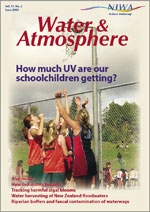PDF of this article (264 KB)

New Zealand Schools Climate Change Competition
NIWA is a sponsor of an exciting new competition set to engage young people in the critical issue of climate change. Other sponsors include BP, RSNZ, GNS, and Futures Thinking Aotearoa.

The competition, which runs until early November, gives students the opportunity to take part in a global scientific experiment. Students first download and run the climateprediction.net computer modelling experiment on a home or school computer. They then complete a PowerPoint presentation which must include some specific data from their model run, a summary of their climate forecast, and a discussion of strategies that will be necessary – in a New Zealand context – to adapt to these potential changes.
Climateprediction.net is one of the world’s most successful and large-scale experiments to focus on climate change in the 21st century. Developed at Oxford University and coordinated by New Zealand climate scientist Dr Dave Frame, the experiment uses the power of thousands of work and home computers worldwide to gather the required information. Climateprediction.net will help scientists predict the climate in the future by ‘quantifying the uncertainties’ in climate prediction.
The New Zealand Schools Climate Change Competition is coordinated by Phil Kendon, an RSNZ Science, Maths and Technology Teacher Fellow for 2005, who is based at NIWA in Wellington. Prizes for the best presentations include up to $500 in cash for the students themselves and a high-spec digital camera for their school.
Full details of the competition are available on NIWA’s website.
For further information, contact: Phil Kendon, 0-4-386 0368, [email protected]
Lessons on a reef
NIWA is helping teachers spread the lessons learnt from our biodiversity work with children at Makaurau Marae, Ihumātao, Manukau.

For the last forty years, the marae’s taonga kai moana reef, Ngā Kuia e Toru, has been covered by a thick layer of mud and Pacific oysters due to circulation changes caused by the Mangere Sewage Treatment Plant oxidation ponds. When the ponds were built around Puketutu Island, water flow around the reef ceased.
After the pond walls were removed in 2003 as a part of Watercare’s Project Manukau restoration project, the reef began to slowly clear. The ponds have now been dredged and the reef and estuary opened up once again to tidal influences.
Over the last three years NIWA has helped parents and children at the marae to get reacquainted with the animals and plants on their recovering reef. In March 2004, parents and children went on a hikoi wānanga (fieldtrip) to the edge of Ngā Kuia e Toru to learn local names and ecology of the animals and plants on the reef. A poster featuring this fieldtrip and what the children learnt on the day has been produced for their schools.
In May 2005, NIWA and Auckland University’s TEAM Solutions held a teachers’ in-service workshop (kura and wharekura) to re-create the March 2004 hikoi wānanga, and to help teachers translate the project into a curriculum resource that they can use in their own schools.
For further information, contact: Dr Michelle Kelly, 0-9-375 2037, [email protected]
